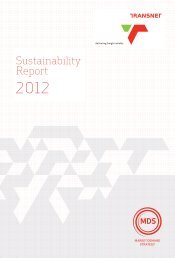Standard Operating Procedures for Container Terminals ... - Transnet
Standard Operating Procedures for Container Terminals ... - Transnet
Standard Operating Procedures for Container Terminals ... - Transnet
You also want an ePaper? Increase the reach of your titles
YUMPU automatically turns print PDFs into web optimized ePapers that Google loves.
1.1.27. “departure stow plan” means the in<strong>for</strong>mation provided by the Customer<br />
to the Terminal Operator in terms of Clause 2.10.3.5 below, as<br />
subsequently revised by the Customer;<br />
1.1.28. “technical data” in Clause 2.2.1 below means the in<strong>for</strong>mation required in<br />
the <strong>for</strong>ms annexed hereto marked SOPCT Appendix “A” and SOPCT<br />
Appendix “B”;<br />
1.1.29. “stack dates” means the official dates advertised by the Terminal<br />
Operator during which export containers must be brought into the<br />
Terminal without incurring additional charges <strong>for</strong> early or late arrival at<br />
the Terminal;<br />
1.1.30. “early arrival container” means a container that arrives in the Terminal<br />
be<strong>for</strong>e the stack into which it is to be taken has been opened. The<br />
acceptance of “early arrival containers” is at the discretion of the<br />
Terminal Operator and additional charges will be raised in respect of<br />
early arrival containers;<br />
1.1.31. “late arrival container” means a container that arrives in the Terminal<br />
after the stack into which it is to be taken up has been closed. The<br />
acceptance of “late arrival” containers is at the discretion of the Terminal<br />
Operator and additional charges will be raised in respect of late arrival<br />
containers;<br />
1.1.32. “cut and run” means the Customer’s right to sail the vessel without<br />
discharging or loading the vessel as planned in order to maintain<br />
schedule integrity;<br />
1.1.33. “shut out containers” means those containers which, although taken into<br />
the stack <strong>for</strong> loading aboard the vessel, are in fact not loaded and<br />
remain in the stack due to the Customer’s decision not to load all the<br />
containers which were originally intended <strong>for</strong> loading on the vessel<br />
concerned, either because the vessel is unable to accommodate the<br />
containers or <strong>for</strong> reasons other than maintaining schedule integrity;<br />
1.1.34. “operator code” refers to the internationally accepted three-character<br />
code assigned to each Customer/Vessel Operator. This code must be<br />
reflected on all bay plan in<strong>for</strong>mation, and EDIFACT interchanges;<br />
1.1.35. “7 day ETA notification” means the first notification from the Customer to<br />
the Terminal Operator which sets out an estimated time of arrival of one<br />
of the Customer’s vessels, which time of arrival falls on the 7th day<br />
following on (but excluding) the day on which such notification is<br />
received by the Terminal Operator: <strong>for</strong> example, a “7 day ETA<br />
SOPCT 01/04/2013 – 31/03/2014<br />
TRANSNET PORT TERMINALS, A DIVISION OF TRANSNET SOC Ltd Page 6 of 54

















